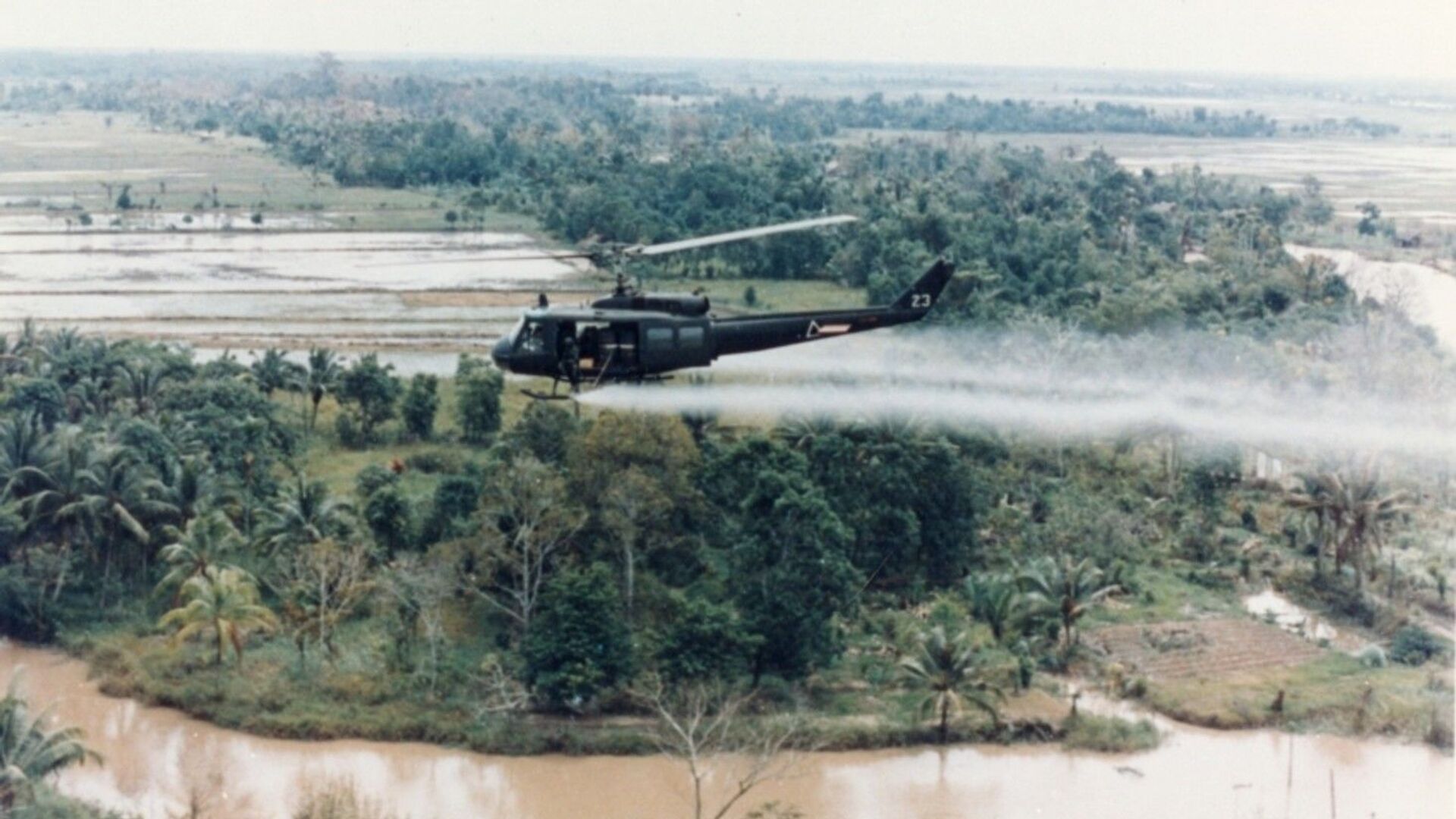August 10th: Remembering a Day of Tragedy for the People of Vietnam
07:01 GMT 10.08.2022 (Updated: 07:03 GMT 10.08.2022)
Subscribe
On this day, August 10, 1961, the United States began chemical warfare in Vietnam War, having sprayed 77 million liters of defoliants over South Vietnam by the end of 1971. Of that amount, 44 million liters contained dioxin, which causes various diseases and genetic mutations in humans and other living beings exposed to it.
Some three million Vietnamese were affected by direct contact with dioxin in that decade.
14% of the territory of South Vietnam was exposed to this toxin, causing severe consequences for the land and nature. Five thousand square kilometers of mangrove forests were almost completely destroyed; about 10,000 square kilometers of jungle and more than a thousand square kilometers of lowland forests were affected. American troops destroyed 70% of the coconut plantations and 60% of the Gewea plantations; they also changed the ecological balance of Vietnam.
The affected areas lost 18 out of 150 bird species; nearly all amphibians and insects disappeared; the number of fish in rivers decreased, and their composition changed. The microbiological composition of soils was disturbed. Changes in the fauna resulted in the replacement of black rats, which are safe for humans, with other species that were plague carriers. Alterations in the mosquito species composition led to the introduction of malaria-carrying ones. Dioxin: A Permanently Exploding Bomb The large-scale US use of chemical warfare in Vietnam lasted until late 1971. But this war was not over for Vietnam itself, said Professor Andrei Kuznetsov, director general of the Russian Division of the Joint Russo-Vietnamese Research and Technology Tropical Center, in an interview with Sputnik.
“This is because dioxins, once inside the human body, begin to work like an HIV infection. If a person is completely healthy, they do not affect him. As soon as the human immune system weakens and any disease begins, dioxins immediately get integrated into the disease chains and start working in their own way. No one knows just how. They can cause cancer, damage to the liver, skin, respiratory system, and much more. Dioxin pathology is very diverse. And the most tragic thing is that it is inherited through mother's milk. More than a million and a half Vietnamese in the three postwar generations have suffered from it. For an extremely long time, for many generations, dioxins will continue to be passed on from women to their children. Moreover, there is no minimum permissible dose for dioxins,” says Andrei Kuznetsov.
Today, Vietnam faces the ever-present threat that children will be born with a wide variety of defects. To this day, several villages there are closed to the public, where children are born into families with various deformities. There are several specialized boarding schools where children with genetic defects live. Scientists from different countries have been studying the effects of dioxin on soil for a long time, but only in temperate and northern climates. No one has studied its impact in the tropics. There have been no studies on what happens when dioxin molecules enter the soil under tropical conditions, continued Professor Kuznetsov.
“The Joint Russo-Vietnamese Research and Tropical Technology Center is the first and only one to address this issue. It was commonly believed that dioxin molecules were insoluble. Supposedly, humus binds them and they remain in the top layer of the soil. One could bulldoze or even shovel it and burn it. But it turns out that things are different in the tropics. Dioxin molecules bind with various acids in the soil, forming new dioxin-containing molecules that become water-soluble and water-permeable. They mix with rainfall streams, sink into the soil, get transported by subsurface water, and subsequently enter wells, lakes, rivers, and seas hundreds of kilometers away from where they were sprayed. This situation persists in Vietnam to this day. There are several ‘hot spots’; places where, during the aggression, the Americans stored barrels with chemical agents. When they left Vietnam, they shot these barrels with large-caliber machine guns and left them there. For example, this happened in Da Nang, which was one of the largest US military bases. And the same happened at the US military base in Bien Hoa. These two former bases are still the largest and scariest hotbeds of contamination,” said Andrei Kuznetsov.
The expert also noted that the Americans recently have conducted a demonstrative action in Da Nang – and have now begun it in Bien Hoa – to decontaminate the soil to a depth of two meters in those places where barrels with warfare agents were stored. But they don`t check the level of dioxin contamination even within the radius of 200-300 meters from the storage sites. Meanwhile, subsurface water transports pesticides far beyond those limits.
The Mission of Joint Tropical Center The Joint Russo-Vietnamese Research and Technology Tropical Center has been studying the consequences of the US chemical war in Vietnam since its founding. In fact, it was established precisely for this work, noted Professor Kuznetsov.
“We were tasked with determining whether contact with dioxin leads to genetic changes in humans and has a detrimental effect on soil, flora, and fauna. Our conclusion - yes, it does. The results of our work were published and reported to the leadership of Vietnam’s Ministry of National Defense and Ministry of Health, together with our scientific and practical recommendations on combating various dioxin-related effects. At the same time, we noted that the most effective, global way to prevent dioxins from damaging people is to take maximum care of their health. That is, Vietnam needs to invest much more in health care than countries that have not been exposed to this toxic chemical. We cannot yet say when the effects of US chemical warfare will cease in Vietnam. After all, Vietnam is the first and only country to have been exposed to such massive amounts of poisonous substances,” Kuznetsov concluded.



